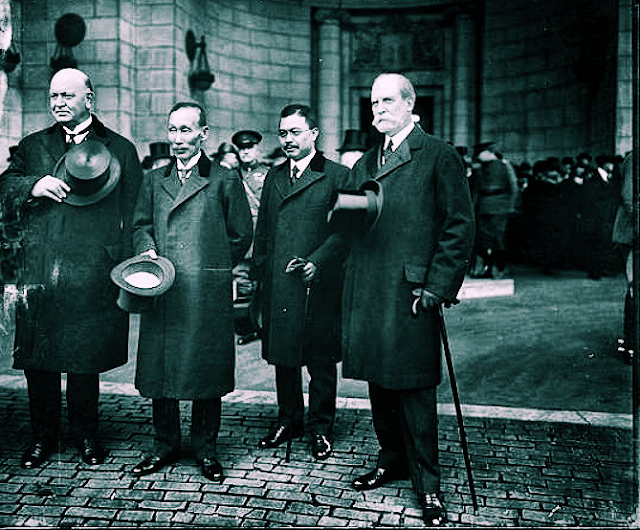 |
| Conference Session of 21 November 1922 |
Between late 1921 and 1922, the world’s largest naval powers gathered in Washington, DC, for a conference to discuss naval disarmament and ways to relieve growing tensions in East Asia. More formally known as the International Conference on Naval Limitation, the Washington Naval Conference was a disarmament effort occasioned by the hugely expensive naval construction rivalry that existed among Britain, Japan, and the United States. Senator William E. Borah, Republican of Idaho, took the lead on this matter and urged that the major Allied nations from the recent war gather in an effort to slow the arms race. The proposal was not met with initial enthusiasm by the Harding administration, but it became a political imperative when it was portrayed as a Republican alternative to League of Nations’ peace efforts. In the summer of 1921, Harding extended invitations and expanded the agenda beyond arms control to include discussion of issues in the Pacific and Far East.
The formal opening of the Washington Naval Conference occurred on Armistice Day 1921. The major naval powers of Britain, France, Italy, Japan, and the United States were in attendance as well as other nations with concerns about territories in the Pacific—Belgium, the Netherlands, Portugal, and China—who were not parties to the disarmament discussions. Soviet Russia was not invited nor were the defeated Central Powers. The American delegation was led by Charles Evans Hughes, the secretary of state, and included Elihu Root, Henry Cabot Lodge, and Oscar Underwood, the Democratic minority leader in the Senate.
In the initial session, Hughes shocked the delegates by going beyond platitudes and offering a detailed plan for arms reduction. Labeled by some as one of the most dramatic moments in American diplomatic history, Hughes called for the scrapping of nearly two million tons of warships and a lengthy “holiday” on the construction of new ships. He was widely hailed in the press as a savior, but leaders of the other Allied governments were quietly skeptical. Over the following weeks, a series of agreements was concluded, the most famous of which involved limitations on fleet sizes, the use of submarines in future wars, and the outlawing of poison gas.
 |
| Secretary of State Hughes Greets Japan's Delegates |
Five-Power Naval Limitation Treaty. This agreement implemented the sweeping proposals of Hughes in somewhat modified terms. The leading naval powers—Britain, France, Italy, Japan, and the United States—pledged adherence to limitations on the tonnage of capital ships and accepted a moratorium on new naval construction.
Five-Power Supplemental Treaty. The major Allied naval powers agreed on a series of rules for the use of submarines in future warfare and also outlawed the use of poisonous gases as a military weapon.
In the following months, the U.S. Senate ratified all of the treaties from the Washington Conference. However, a reservation was attached to the Four-Power Pact stating that no agreement had been approved that required the “commitment of armed force” by the United States.
Source: U-S-History.com

No comments:
Post a Comment